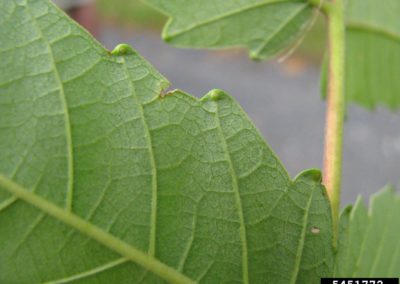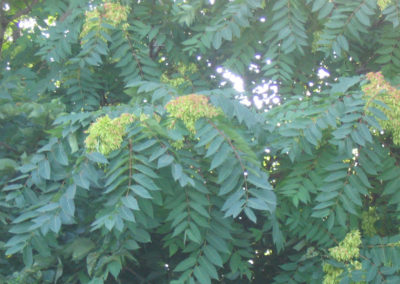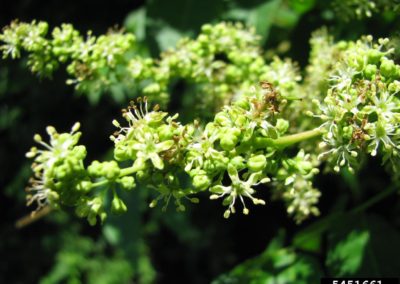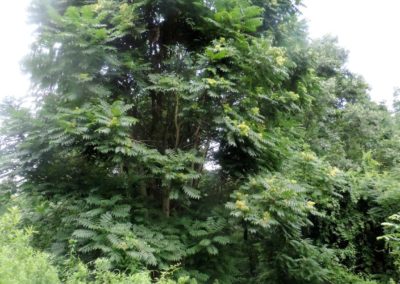Tree of Heaven (Ailanthus altissima)
Invasive Management Profile
Although beautiful, Tree of Heaven is invasive in Indianapolis.
Identification
Tree of Heaven can be identified easily by its angel wing-like leaves. They are 2-6 inches long with a pointed tip and teeth near the bottom. When crushed the leaves give off a foul odor. Tree of Heaven’s flowers are primarily yellow/green and can be found in 6-12 inch clusters. In the late spring and early summer, the seeds will give off a foul smell which is also a good way to identity this plant. The bark of Tree of Heaven when young is thin and light brown to gray. As it ages, the bark turns darker gray and rough. The tree will typically grow up to 70 feet tall (but sometimes up to 100 feet) with large open branches. When there is one Tree of Heaven, you will typically find many. If you are having trouble identifying the Tree of Heaven, break off a twig, which should be greenish to brown in color. Break open the twig to reveal a large, spongy, brown center.
Tools & Supplies Needed
- Shovel, spade, or lopper
- Protective eyewear, gloves, and clothing
- Paper or plastic bags for disposal
Be sure to wear protective clothing when dealing with Tree of Heaven. Some people receive an allergic reaction to the pollen of Tree of Heaven and some people develop a rash from exposure to Tree of Heaven sap. Chance of reaction increases with increased exposure to pollen/ sap. Prolonged exposure to sap by broken skin can cause serious health reactions that may require hospitalization i.e. chest pain and increased heart rate. Some research suggests it may cause myocarditis, an uncommon inflammation of the heart.
Removal Methods
Use the pulling method for small quantities of Tree of Heaven saplings.
STEP 1 : Identify plant using our identification tips and photos as well as the time of year and growth stage.
STEP 2 : Wear protective eyewear, gloves, and clothing.
STEP 3 : Use your hand to grab the bottom of the plant, twist, and pull.
STEP 4 : When pulling, make sure to remove the taproot, which is the main root system (this may be easily removed with a spade or shovel as well).
STEP 5 : Make sure to place all plant debris into a plastic or paper bag to control seed spread.
In some cases, where the Tree of Heavem is extremely dense, a chainsaw may be needed to cut back stems and thorny branches.
STEP 1 : Identify plant using our identification tips and photos as well as the time of year and growth stage.
STEP 2 : Wear protective eyewear, gloves and clothing.
STEP 3 : After reading all safety labels, use a chainsaw to cut the tree 5 inches from the ground.
STEP 4 : Treat with herbicide or proceed to step 5 in Cut Stump Method.
STEP 5 : Make sure to collect and bag any fallen fruit from the Autumn Olive to prevent seed dispersal.
Tree-of-heaven is a prolific root-sprouter. Monitor for resprouts and remove until full control is achieved.
Disposal
For disposal of Tree of Heaven, package the plant waste in a large plastic or paper bag for landfill. Small sapling shrubs can be disposed of in the trash and will be picked up through regular trash collection. Large trees can be picked up through heavy trash collection. Heavy trash collection guidelines and monthly pick-up days for your address can be found here.
Beyond trash collection services, you may need to either hire someone to come and remove the yard waste generated from Tree of Heaven removal or haul the waste away yourself. Many landscaping companies will accept yard waste for a small cost. They then process this material into mulch or compost. Click here to learn more about tree removal services in your area.
Native Alternative Species
To learn more about natives and how to landscape with them click here.




